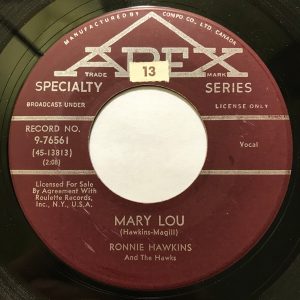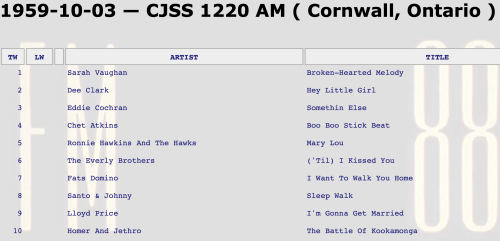#2: Mary Lou by Ronnie Hawkins
City: Cornwall, ON
Radio Station: CJSS
Peak Month: October 1959
Peak Position in Cornwall ~ #5
Peak position in Vancouver ~ #13
Peak Position on Billboard Hot 100 ~ #26
YouTube: “Mary Lou”
Lyrics: “Mary Lou”
Ronnie Hawkins was born in Huntsville, Arkansas, on January 10, 1935, two days after Elvis Presley. Hawkins’ mother was a teacher; his father, a barber. Known affectionately over the years as “Mr. Dynamo,” “Sir Ronnie,” “Rompin’ Ronnie,” and “The Hawk,” Hawkins’ love of music started in high school. He formed the first version of his band The Hawks while studying at the University of Arkansas in the 1950s. Ronnie remembers, he’d commandeer an old gas station on Dickson street for rehersals. “We’d unplug their outside Coke machine and plug in our instruments,” Hawkins said. “They had the warmest Cokes in town.” In 1958, on the recommendation of Conway Twitty – who considered Canada to be the promised land for a rock’n roll singer – Hawkins came to Hamilton, Ontario to play a club called The Grange. He never left. Adopting Canada as his home, Hawkins became a permanent resident in 1964. In 1958 he released his first single, “Hey, Bo Diddley”.
This was followed the next year by “Mary Lou”.

“Mary Lou” was written by Ronnie Hawkins and Jacqueline Magill (aka Morris Levy). On the self-titled Ronnie Hawkins album in 1959, eleven out of twelve tracks were credited to Hawkins-Magill. I suspect Morris Levy never lifted a pen to write either lyrics or music for any of these tunes, including “Mary Lou”. But as the boss of Roulette Records, Levy was able to twist recording artists arms and get some extra royalties coming his way.
Morris Levy had arranged a contract with the Bobby Fuller Four in 1966. Bobby Fuller was increasingly uncomfortable with the deal and wanted to get out of it. Weeks later, it happened that Bobby Fuller was found dead and likely murdered. In December 1967, recording artist Jimmie Rogers was stopped by three Los Angeles police for erratic driving and beaten, resulting in a skull fracture. A lawsuit ensued and was settled out of court. Rodgers never regained his vocal abilities after the attack. In Me, the Mob, and the Music, fellow Roulette Records recording artist, Tommy James, alleged that the incident with Jimmie Rodgers was due to Morris Levy ordering the hit on Rodgers where he was beaten by three police who were taking a bribe from the Mafia. In the memoir, James recounts that Levy hardly paid any royalties to any of Roulette’s recording artists. After his 1971 solo hit, “Draggin’ The Line”, Tommy James moved away from New York City, fearful of being a fatality from a mob hit.
“Mary Lou” is a song about a woman who is no good and makes fools of men. She has a way of charming them and taking their possessions. Hawkins sings, “She makes a young man groan and an old man pain. The way she took my money was a crying shame.” He goes on to list the things she takes from him 1) diamond ring, 2) watch and chain, 3) Cadillac, 4) Fifty-Five Ford, and 5) Two-dollar bill. As well, she leaves him stranded in Kalamazoo (Michigan). In between taking the Cadillac from him, she got a “rich man and had a dozen kids.” And with her rich man, we are told “she drove that cat until he flipped his lid.” To flip ones’ lid is to lose one’s reason or composure. Perhaps Mary Lou drove him insane.
“Mary Lou” peaked at #1 in Potsdam (NY), #3 in Pittsburgh (PA), and Minneapolis/St. Paul, #5 in Cornwall (ON), and Memphis, #6 in Buffalo, and Denver, #7 in Chicago, and Dearborn (MI), #8 in Austin (TX), #9 in Washington D.C., #10 in Tampa (FL), and #13 in Vancouver (BC) and Portland (OR).
“Mary Lou” turned Hawkins into a teenage idol, along with his next single release in 1959, “Forty Days”. In 1959, Morris Levy signed Hawkins to Roulette Records for five years. Levy tried to lure him back to the United States, but Hawkins had fallen in love with Canada and didn’t want to leave his new home.
In 1960 Hawkins had a Top Ten hit in Toronto with “Southern Love”. He repeated Top Ten success in southwestern Ontario in 1963 on the powerful CHUM 1050 AM radio with a cover of “Bo Diddley”. He was again in the Top Five on CHUM in 1965 with “Bluebirds Over The Mountain”. In January 1968 “Home From The Forest” became a #1 hit for Hawkins in Vancouver.
Over the years Ronnie Hawkins gained recognition for recruiting and grooming outstanding Canadian talent. The membership of his band, The Hawks, kept changing as the talent flowed in and out, but the name stayed the same. One edition of The Hawks (with Canadians Richard Manuel, Garth Hudson, Rick Danko, and drummer Levon Helm) moved on to become Bob Dylan’s backup band and recorded with Dylan on Blonde On Blonde, Self Portrait and The Basement Tapes.
Later the Hawks achieved superstardom as The Band, recording “Up On Cripple Creek”, “The Weight” and other memorable songs. Another incarnation became Janis Joplin’s Full Tilt Boogie Band, and another Robbie Lane and the Disciples. Other famous Hawk alumni include David Clayton Thomas of Blood Sweat and Tears, actor Beverly D’Angelo, musician Lawrence Gowan, and fellow Canadian Music Hall of Fame inductees Burton Cummings and David Foster.
At the height of the 1960s peace movement, Hawkins invited John Lennon and Yoko Ono to his Ontario farm to plan a peace festival during the couple’s peace crusade. John Lennon signed his erotic “Bag One” lithographs during his stay at Hawkins’ farm. He also accompanied them on the train to Ottawa in December 1969 for Lennon and Ono’s famous visit with Prime Minister Trudeau. Hawkins later toured the world at Lennon’s request as a peace emissary for Lennon’s “Love Not War” message.
In the midst of Ronnie Hawkins’ political activism with John Lennon and Yoko Ono, Hawkins released the single, “Down In The Alley”. It was a Top Ten hit in Vancouver (BC) in March 1970. By 1970 Ronnie Hawkins was at the twilight of his appeal on the pop charts. However, he began to chart eight singles on the Canadian country charts in 1970, his last climbing the country charts in 1995.
Hawkins won a Juno for best Country Male Vocalist in 1984 for his hit, “Making It Again”. In 1989, Ronnie was reunited with The Band at the concert marking the destruction of the Berlin Wall. In 1992, he performed at the inaugural party of former President Bill Clinton, one of The Hawks’ biggest fans. That same year he received another Juno Award nomination. Hawkins has also performed in a handful of films including, The Last Waltz (with The Band), Heaven’s Gate (with Kris Kristofferson) and Renaldo & Clara (which Bob Dylan produced). Ronnie Hawkins released his 27th album Still Cruisin’ in Canada in 2002. In 2013 Hawkins received the Order of Canada for his many contributions to culture through his music.
October 14, 2023
Ray McGinnis
References:
“Ronnie Hawkins Biography,” Ronniehawkins.com.
Lennon and Ono’s famous visit with Prime Minister Trudeau, Beatles Bible.com
Bed-ins for Peace, Wikipedia.org
Martin Scorsese, The Last Waltz, United Artists, 1978.
Michael Cimino, Heaven’s Gate, United Artists, 1980.
Gloria Galoway, “One in 10 Canadian Vets of Afghan War Diagnosed with PTSD,” Globe and Mail, Toronto, January 22, 2016.
For more song reviews visit the Countdown.


Hi Ray,
I just read your latest offering below.
Not mentioned is the fact that Mary Lou is actually a cover of a June 1955 release by Young Jesse. How Hawkins and Levy hoodwinked everyone regarding the writing credits is interesting.
Young Jesse actually wrote it as well – https://en.wikipedia.org/wiki/Young_Jessie At one time in my life I had a copy of this Modern Records 45.
Young Jesse’s version of Mary Lou – https://www.youtube.com/watch?v=OMoLGe1-x4c
Also, Ronnie Hawkins “Forty Days” is a cover of Chuck Berry’s “Thirty Days.”
I have a Ronnie Hawkins reissue of a Mary Lou / Forty Days on my jukebox. In both cases, Ronnie’s versions sound so much better.
Cheers, Tom